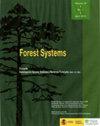点模式分析法表征冷杉林空间结构
IF 0.7
4区 农林科学
Q3 FORESTRY
引用次数: 10
摘要
研究目的:了解摩洛哥冷杉(Abies marocana Trab)森林结构和多样性受随机因素或群落相互作用影响的小尺度格局。研究区域:Talassemtane冷杉林,Talassemtane国家公园,Rif山脉,摩洛哥北部。材料与方法:选取8个具有代表性的马罗卡纳森林结构变异性样地,对胸径≥2 cm的所有个体进行制图和测量。我们进行了四种类型的空间点格局分析:(1)单变量分析,以探索整体树木的空间格局;(2)双变量分析,以评估幼树和摩洛哥杉树成树之间的空间关系;(3)利用单变量标记相关函数,分析树长(dbh)与点对之间距离的相关性;(4)优势和受抑制摩洛哥杉树个体之间的随机标记分析,以评估竞争模式。主要结果:杉木个体具有很强的空间聚集性,幼树与成树之间存在着种内正相关关系。然而,树形大小的距离依赖性较弱,抑制模式的密度依赖性较强。研究重点:耐荫性、种子传播和/或微站点异质性可能在观察到的杉木模式中起重要作用。我们的研究结果提供了关于摩洛哥冷杉林内空间分布的基本知识,对这些遗迹森林的适应性管理具有重要意义,并促使进一步的研究来验证先进的假设。附加关键词:摩洛哥杉木;Talassemtane国家公园;Rif森林;空间分析;摘要统计信息;便利;聚合。使用缩写:MF(摩洛哥冷杉);塔拉assemtane国家公园;胸径(胸高处直径);单变量对相关函数(g(r));非均相泊松;二元对相关函数(g12(r));单变量标记相关函数(kmm(r)),标记连接函数(p12(r))。本文章由计算机程序翻译,如有差异,请以英文原文为准。
Characterizing spatial structure of Abies marocana forest through point pattern analysis
Aim of study: Understanding small-scale patterns caused by stochastic factors or community interactions driving forest structure and diversity of Moroccan fir Abies marocana Trab.Area of study: Talassemtane fir forest, Talassemtane National Park, Rif Mountains, northern Morocco.Material and methods: Eight plots representative of the structural variability of A. marocana forests were selected, and all tree individuals with diameter at breast height (dbh) ≥2 cm were mapped and measured. We performed four types of spatial point pattern analyses: (1) Univariate analyses to explore the overall trees spatial pattern, (2) bivariate analyses to assess the spatial relationship between juveniles and A. marocana adults, (3) correlation between tree sizes (dbh) and distance between points pairs using the univariate mark correlation function, and (4) random labeling analyses between dominant and suppressed Moroccan fir individuals to assess competition patterns.Main results: We found a strong spatial aggregation of fir individuals and a positive intraspecific association between juveniles and adult trees. However, there were weak but significant distance-dependent effect on tree size and density-dependent effect on suppression pattern.Research highlights: Shade-tolerance, seed dispersal and/or microsite heterogeneity might play important roles in the observed fir patterns. Our results provide a basic knowledge on within-stand Moroccan fir spatial distribution, with implications for adaptive management of these relic forests, and prompting to further research to test advanced hypotheses.Additional key words: Moroccan fir; Talassemtane National Park; Rif forest; Spatial analysis; summary statistics; facilitation; aggregation.Abbreviations used: MF (Moroccan fir); Talassemtane National Park (TNP); dbh (diameter at breast height); Univariate pair-correlation function (g(r)); Heterogeneous Poisson (HP); Bivariate pair-correlation function (g12(r)); Univariate mark correlation function (kmm(r)), Mark connection function (p12(r)).
求助全文
通过发布文献求助,成功后即可免费获取论文全文。
去求助
来源期刊

Forest Systems
FORESTRY-
CiteScore
1.40
自引率
14.30%
发文量
30
审稿时长
6-12 weeks
期刊介绍:
Forest Systems is an international peer-reviewed journal. The main aim of Forest Systems is to integrate multidisciplinary research with forest management in complex systems with different social and ecological background
 求助内容:
求助内容: 应助结果提醒方式:
应助结果提醒方式:


